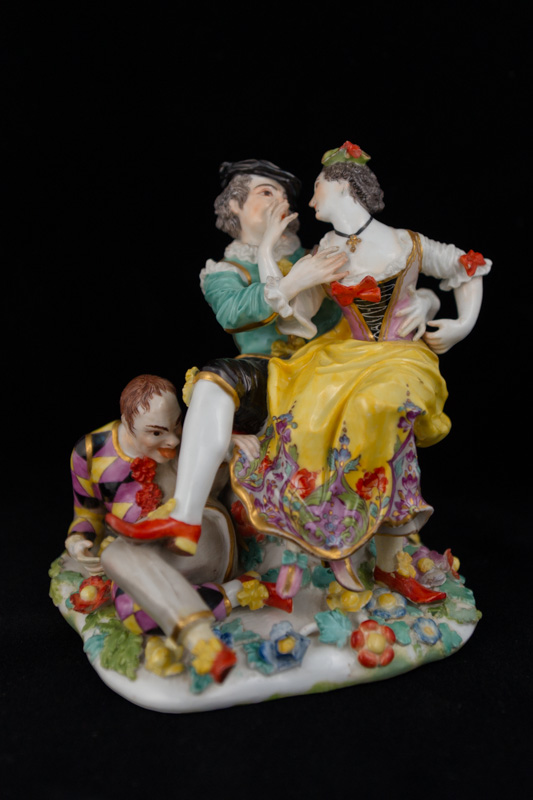Carol & Ryland Scott Porcelain Collection (for sale)
Part of the original collection by Cleo M. & George Ryland Scott


P005 - MEISSEN GROUP OF “INDISCREET HARLEQUIN”
Circa 1742, modeled by J. J. Kändler
Modeled with Columbine seated on Beltrame's lap in an amorous embrace, Harlequin at their feet, sticking out his tongue while peeping up Columbine's skirt, on a shaped mound base applied with flowers and foliage
6 1/8 in. (15.6 cm) wide; 6 in. (15.2 cm) high
LITERATURE
Cleo M. and G. Ryland Scott Jr., Antique Porcelain Digest, Newport, England, 1961, pp. 146-147, fig. 8.
8. MEISSEN. INDISCREET HARLEQUIN. Modeled by Kandler. Early flat type base with unglazed bottom. Applied flowers unusually large. Colors very intense, and modeling throughout exceptionally sharp. Crossed swords mark on unglazed bottom. c. 1740. 6-3/4" h.
See Meredith Chilton, Harlequin Unmasked (Singapore, 2001), p. 138, fig. 225 and pp. 304-305, no. 93 for the example of this model in the Gardiner Museum of Ceramic Art, Toronto. Chilton suggests that the group could have been derived from a blend of two separate print sources. She suggests that the couple's pose could be derived from one of Petrus Schenk's series of twelve engravings, 'Les Amours de Columbine' (which show Columbine 'paired in amorous positions with almost every male member of the troupe') showing Columbine seated on Harlequin's lap (illustrated p. 138, fig. 226). She suggests that Harlequin's pose could be based on Gregorio Lambranzi's engraving from 'The New and Eccentric School of Theatrical Dancing', where Harlequin is shown 'concealed' on the ground and reaching up 'in order to steal from an unsuspecting blind beggar' (illustrated p. 138, fig. 227).
The Pauls-Eisenbeiss example is illustrated by Erika Pauls-Eisenbeiss, German Porcelain of the 18th Century Collection Catalogue (London, 1972), pp. 268-269, where other examples are also listed.
Penny J. Sander, “European porcelain in the High Museum of Art, Atlanta, Georgia”, The Magazine Antiques, January 1982, , The Magazine Antiques, p. 295, pl. IX.
SIMILAR ITEM IN MUSEUMS
The Metropolitan Museum of Art, New York, NY in gallery 538
Gardiner Museum, Toronto, Ontario, Canada – item G 83.1.913
Birmingham Museum of Art, Birmingham, AL
EXHIBITION
On display in the Scott-Allen Collection at The High Museum of Art, Atlanta, Georgia from 1976 until 1996
NOTES BY CLEO M. AND G. RYLAND SCOTT, JR in the late 1950’s
This figure is known as "The Indiscreet Harlequin" and represents Kandler at his best. The "Harlequins" are, of course, considered among the best figures modeled by him.
This figure represents two lovers engaged in intimate conversation, while all unknown to them, the Harlequin is lifting the ladies dress for a "Peek." The lady is wearing a full skirt of yellow, the bottom of which is decorated with flowers in red, green and puce. Her bodice is puce with a black laced front. Her sleeves are white with red bows at the elbow. Her shoes are puce with turquoise bows. She is wearing a small tricorn hat of green with a red bow. She has a black necklace with a gold cross around her neck. The entire costume with appropriate gold borders.
The man is wearing a black hat, white ruffled collar, blue blouse with yellow bow, black pants to his knees, with yellow bow, white stockings, red shoes with yellow bow. He has spread out an intense red robe over a rock or stump upon which they are seated. His suit also appropriately trimmed with gold.
The Harlequin is reclining, with one foot out stretched, the other under his body. He is wearing the usual checkered suit to cover one half of his body, the other half in an unusual grayish brown color, The diamond shaped checks are intense yellow, puce and black with rosettes down the front in red, a red belt and red shoes with white socks and yellow bows. His hair is brown, while the lovers hair is black.
The base is of the early flat type with unglazed bottom and applied flowers added of unusual large size, which is indicative of an early specimen.
The colors are all of the very intense hue found at the early period and the modeling throughout is exceptionally sharp. A truly fine specimen.
Specimens from the same mould are to be found in a number of the top collections.
We purchased this one in Paris in 1950 from Armand Wittekind, one of the best known dealers in Meissen Figures. He said this one was certainly not later than 1740.
Webmaster - Ryland Scott
© 2013, Ryland Scott